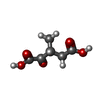[English] 日本語
 Yorodumi
Yorodumi- PDB-6yyx: Aspartyl/Asparaginyl beta-hydroxylase (AspH) oxygenase and TPR do... -
+ Open data
Open data
- Basic information
Basic information
| Entry | Database: PDB / ID: 6yyx | ||||||
|---|---|---|---|---|---|---|---|
| Title | Aspartyl/Asparaginyl beta-hydroxylase (AspH) oxygenase and TPR domains in complex with manganese, 3-methyl-2-oxoglutarate, and factor X substrate peptide fragment(39mer-4Ser) | ||||||
 Components Components |
| ||||||
 Keywords Keywords | OXIDOREDUCTASE / Aspartyl/asparaginyl beta-hydroxylase / Dioxygenase | ||||||
| Function / homology |  Function and homology information Function and homology informationpeptide-aspartate beta-dioxygenase / : / regulation of protein depolymerization / activation of store-operated calcium channel activity / regulation of cell communication by electrical coupling / junctional sarcoplasmic reticulum membrane / peptidyl-aspartic acid 3-dioxygenase activity / sarcoplasmic reticulum lumen / limb morphogenesis / positive regulation of intracellular protein transport ...peptide-aspartate beta-dioxygenase / : / regulation of protein depolymerization / activation of store-operated calcium channel activity / regulation of cell communication by electrical coupling / junctional sarcoplasmic reticulum membrane / peptidyl-aspartic acid 3-dioxygenase activity / sarcoplasmic reticulum lumen / limb morphogenesis / positive regulation of intracellular protein transport / cortical endoplasmic reticulum / coagulation factor Xa / pattern specification process / Defective factor IX causes thrombophilia / Defective cofactor function of FVIIIa variant / Defective F9 variant does not activate FX / Extrinsic Pathway of Fibrin Clot Formation / face morphogenesis / structural constituent of muscle / response to ATP / Protein hydroxylation / roof of mouth development / positive regulation of calcium ion transport into cytosol / positive regulation of proteolysis / detection of calcium ion / positive regulation of TOR signaling / Transport of gamma-carboxylated protein precursors from the endoplasmic reticulum to the Golgi apparatus / regulation of cytosolic calcium ion concentration / Gamma-carboxylation of protein precursors / Common Pathway of Fibrin Clot Formation / regulation of cardiac muscle contraction by regulation of the release of sequestered calcium ion / Removal of aminoterminal propeptides from gamma-carboxylated proteins / calcium ion homeostasis / regulation of release of sequestered calcium ion into cytosol by sarcoplasmic reticulum / Ion homeostasis / Intrinsic Pathway of Fibrin Clot Formation / calcium channel complex / sarcoplasmic reticulum membrane / muscle contraction / cellular response to calcium ion / phospholipid binding / regulation of protein stability / calcium ion transmembrane transport / Stimuli-sensing channels / Golgi lumen / blood coagulation / transmembrane transporter binding / electron transfer activity / cell population proliferation / positive regulation of cell migration / endoplasmic reticulum lumen / negative regulation of cell population proliferation / external side of plasma membrane / serine-type endopeptidase activity / calcium ion binding / endoplasmic reticulum membrane / positive regulation of DNA-templated transcription / structural molecule activity / endoplasmic reticulum / proteolysis / extracellular space / extracellular region / plasma membrane Similarity search - Function | ||||||
| Biological species |  Homo sapiens (human) Homo sapiens (human) | ||||||
| Method |  X-RAY DIFFRACTION / X-RAY DIFFRACTION /  SYNCHROTRON / SYNCHROTRON /  MOLECULAR REPLACEMENT / Resolution: 1.53 Å MOLECULAR REPLACEMENT / Resolution: 1.53 Å | ||||||
 Authors Authors | Nakashima, Y. / Brewitz, L. / Schofield, C.J. | ||||||
 Citation Citation |  Journal: Chem Sci / Year: 2021 Journal: Chem Sci / Year: 2021Title: Synthesis of 2-oxoglutarate derivatives and their evaluation as cosubstrates and inhibitors of human aspartate/asparagine-beta-hydroxylase Authors: Brewitz, L. / Nakashima, Y. / Schofield, C.J. | ||||||
| History |
|
- Structure visualization
Structure visualization
| Structure viewer | Molecule:  Molmil Molmil Jmol/JSmol Jmol/JSmol |
|---|
- Downloads & links
Downloads & links
- Download
Download
| PDBx/mmCIF format |  6yyx.cif.gz 6yyx.cif.gz | 223.3 KB | Display |  PDBx/mmCIF format PDBx/mmCIF format |
|---|---|---|---|---|
| PDB format |  pdb6yyx.ent.gz pdb6yyx.ent.gz | 150.9 KB | Display |  PDB format PDB format |
| PDBx/mmJSON format |  6yyx.json.gz 6yyx.json.gz | Tree view |  PDBx/mmJSON format PDBx/mmJSON format | |
| Others |  Other downloads Other downloads |
-Validation report
| Summary document |  6yyx_validation.pdf.gz 6yyx_validation.pdf.gz | 1.1 MB | Display |  wwPDB validaton report wwPDB validaton report |
|---|---|---|---|---|
| Full document |  6yyx_full_validation.pdf.gz 6yyx_full_validation.pdf.gz | 1.1 MB | Display | |
| Data in XML |  6yyx_validation.xml.gz 6yyx_validation.xml.gz | 22.5 KB | Display | |
| Data in CIF |  6yyx_validation.cif.gz 6yyx_validation.cif.gz | 35 KB | Display | |
| Arichive directory |  https://data.pdbj.org/pub/pdb/validation_reports/yy/6yyx https://data.pdbj.org/pub/pdb/validation_reports/yy/6yyx ftp://data.pdbj.org/pub/pdb/validation_reports/yy/6yyx ftp://data.pdbj.org/pub/pdb/validation_reports/yy/6yyx | HTTPS FTP |
-Related structure data
| Related structure data |  5jtcS S: Starting model for refinement |
|---|---|
| Similar structure data |
- Links
Links
- Assembly
Assembly
| Deposited unit | 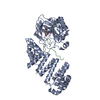
| ||||||||||||
|---|---|---|---|---|---|---|---|---|---|---|---|---|---|
| 1 |
| ||||||||||||
| Unit cell |
|
- Components
Components
| #1: Protein | Mass: 49405.336 Da / Num. of mol.: 1 Source method: isolated from a genetically manipulated source Source: (gene. exp.)  Homo sapiens (human) / Gene: ASPH, BAH / Production host: Homo sapiens (human) / Gene: ASPH, BAH / Production host:  References: UniProt: Q12797, peptide-aspartate beta-dioxygenase |
|---|---|
| #2: Protein/peptide | Mass: 4190.384 Da / Num. of mol.: 1 Source method: isolated from a genetically manipulated source Source: (gene. exp.)  Homo sapiens (human) / Gene: F10 / Production host: synthetic construct (others) / References: UniProt: P00742, coagulation factor Xa Homo sapiens (human) / Gene: F10 / Production host: synthetic construct (others) / References: UniProt: P00742, coagulation factor Xa |
| #3: Chemical | ChemComp-MN / |
| #4: Chemical | ChemComp-Q1Z / ( |
| #5: Water | ChemComp-HOH / |
| Has ligand of interest | Y |
| Has protein modification | Y |
-Experimental details
-Experiment
| Experiment | Method:  X-RAY DIFFRACTION / Number of used crystals: 1 X-RAY DIFFRACTION / Number of used crystals: 1 |
|---|
- Sample preparation
Sample preparation
| Crystal | Density Matthews: 2.6 Å3/Da / Density % sol: 52.67 % |
|---|---|
| Crystal grow | Temperature: 277 K / Method: vapor diffusion, sitting drop / pH: 6.5 Details: 200 mM Bis Tris Propane, 200 mM sodium/potassium phosphate, 20% w/v PEG 3350, 1 mM manganese chloride, 2 mM 3-methyl-2-oxoglutarate, 18 mg/ml protein |
-Data collection
| Diffraction | Mean temperature: 100 K / Serial crystal experiment: N |
|---|---|
| Diffraction source | Source:  SYNCHROTRON / Site: SYNCHROTRON / Site:  Diamond Diamond  / Beamline: I04 / Wavelength: 0.9795 Å / Beamline: I04 / Wavelength: 0.9795 Å |
| Detector | Type: DECTRIS EIGER2 XE 16M / Detector: PIXEL / Date: Jan 19, 2020 |
| Radiation | Protocol: SINGLE WAVELENGTH / Monochromatic (M) / Laue (L): M / Scattering type: x-ray |
| Radiation wavelength | Wavelength: 0.9795 Å / Relative weight: 1 |
| Reflection | Resolution: 1.53→86.59 Å / Num. obs: 48664 / % possible obs: 88.7 % / Redundancy: 11 % / Biso Wilson estimate: 24.55 Å2 / CC1/2: 0.999 / Rmerge(I) obs: 0.068 / Net I/σ(I): 16.6 |
| Reflection shell | Resolution: 1.53→1.71 Å / Rmerge(I) obs: 1.289 / Mean I/σ(I) obs: 1.4 / Num. unique obs: 2433 / CC1/2: 0.665 |
- Processing
Processing
| Software |
| |||||||||||||||||||||||||||||||||||||||||||||||||||||||||||||||||||||||||||||||||||||||||||||||||||||||||||||||||||||||||||||||||||||
|---|---|---|---|---|---|---|---|---|---|---|---|---|---|---|---|---|---|---|---|---|---|---|---|---|---|---|---|---|---|---|---|---|---|---|---|---|---|---|---|---|---|---|---|---|---|---|---|---|---|---|---|---|---|---|---|---|---|---|---|---|---|---|---|---|---|---|---|---|---|---|---|---|---|---|---|---|---|---|---|---|---|---|---|---|---|---|---|---|---|---|---|---|---|---|---|---|---|---|---|---|---|---|---|---|---|---|---|---|---|---|---|---|---|---|---|---|---|---|---|---|---|---|---|---|---|---|---|---|---|---|---|---|---|---|
| Refinement | Method to determine structure:  MOLECULAR REPLACEMENT MOLECULAR REPLACEMENTStarting model: 5JTC Resolution: 1.53→50.21 Å / SU ML: 0.1407 / Cross valid method: FREE R-VALUE / σ(F): 1.34 / Phase error: 27.4488
| |||||||||||||||||||||||||||||||||||||||||||||||||||||||||||||||||||||||||||||||||||||||||||||||||||||||||||||||||||||||||||||||||||||
| Solvent computation | Shrinkage radii: 0.9 Å / VDW probe radii: 1.11 Å | |||||||||||||||||||||||||||||||||||||||||||||||||||||||||||||||||||||||||||||||||||||||||||||||||||||||||||||||||||||||||||||||||||||
| Displacement parameters | Biso mean: 31.61 Å2 | |||||||||||||||||||||||||||||||||||||||||||||||||||||||||||||||||||||||||||||||||||||||||||||||||||||||||||||||||||||||||||||||||||||
| Refinement step | Cycle: LAST / Resolution: 1.53→50.21 Å
| |||||||||||||||||||||||||||||||||||||||||||||||||||||||||||||||||||||||||||||||||||||||||||||||||||||||||||||||||||||||||||||||||||||
| Refine LS restraints |
| |||||||||||||||||||||||||||||||||||||||||||||||||||||||||||||||||||||||||||||||||||||||||||||||||||||||||||||||||||||||||||||||||||||
| LS refinement shell |
|
 Movie
Movie Controller
Controller


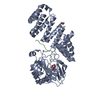



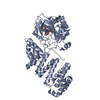
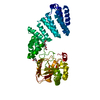

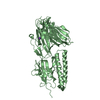


 PDBj
PDBj















